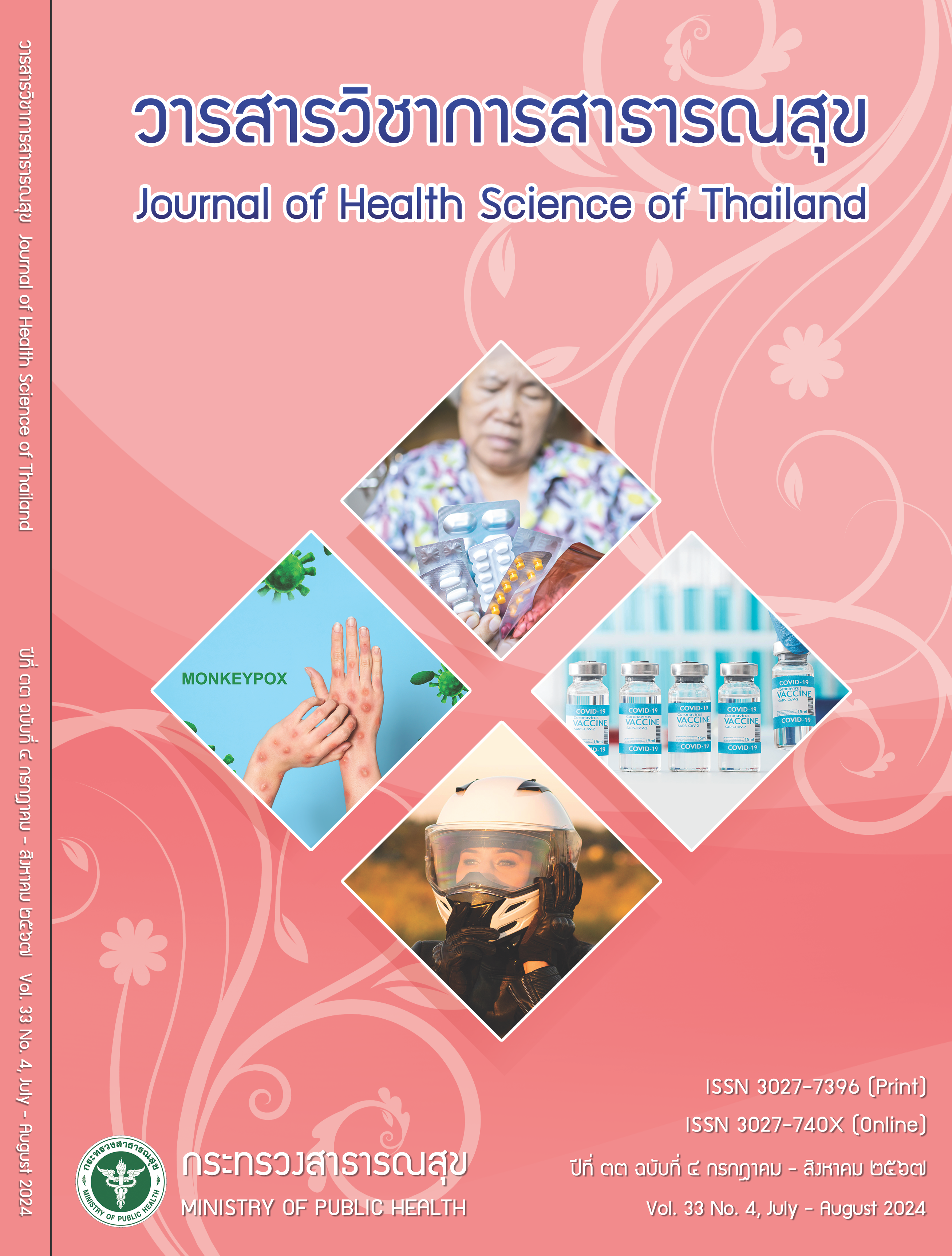Development of Prevention and Control Model for Coronavirus Disease 2019 by the Community Participatory Learning
Keywords:
prevention and control model for COVID-19, community participatory learning, health literacyAbstract
The objective of this study was to develop prevention and control model for COVID-19 by community participatory learning in charge of Nong Bua Kaow sub-district health promoting hospital. The qualitative data were collected during October 2020 – September 2021 via in-depth interviews with 7 experts, group discussion of 36 stakeholders, and 50 household representatives. Content analysis was applied toward quantitative data by health literacy and health preventive behavior for COVID-19 survey of Department of Health Service Support, Ministry of Public Health, which had a sample size of 250 household representatives and evaluation form of model development appropriateness developed by the researchers; and the samples were 26 stakeholders. Data were analyzed by inferential statistics which is paired t-test and descriptive statistics consist of number, percentage, mean and standard deviation. The study found that prevention and control model for COVID-19 in community included 5 components which were (1) management, (2) participation, (3) operating structure, (4) information technology, (5) public health emergency communications. Moreover, results from the development of prevention and control model for COVID-19 had created 6 innovations including (1) an innovative network of prevention and control model for COVID-19 in the community, (2) community health station innovation, (3) primary innovation (fast track), (4) village health volunteer (VHV) delivery, (5) potential development program for VHV, and (6) online community health information management system. Test results of prevention and control model for COVID-19 among the sample of 250 household representatives comparing average score of health literacy revealed that the average score increased statistically significantly (p<0.01) and comparative results for the average score of health preventive behavior for COVID-19 also increased statistically significantly (p<0.01). The research process appropriateness evaluation results of 36 stakeholders group found that overall appropriateness was at the highest level (mean=4.81, SD=0.21). Thus, relevant agencies should utilize the developed operating model and developed innovation to appropriately apply in each context.
Downloads
References
ธีระ วรธนารัตน์, ภัทรวัณย์ วรธนารัตน์, อารียาจิรธนานุวัฒน์. การบริหารจัดการภาวะวิกฤตในช่วงสถานการณ์การระบาดของโควิด-19 ระลอกแรก. วารสารวิจัยระบบสาธารณสุข 2565;16(3):370–88.
World Health Organization. WHO Director-General’s opening remarks at the media briefing on COVID-19 - 11 March 2020 [Internet]. 2020 [cited 2023 Mar 30]. Available from:https://www.who.int/direc¬tor-general/speeches/detail/who-director-general-s-opening-remarks-at-the-media-briefing-on-covid-19- --11-march-2020
เสาวลักษณ์ ศรีดาเกษ, ยลฤดี ตัณฑสิทธิ์, ธีรศักดิ์ พาจันทร์, จิรพงศ์ วสุวิภา. การพัฒนารูปแบบการป้องกันและควบคุมโรคไข้เลืือดออก โดยใช้กระบวนการเรียนรู้แบบมีส่วนร่วมของชุุมชน อำเภอพล จังหวัดขอนแก่น. วารสารเครือข่ายวิทยาลัยพยาบาลและการสาธารณสุขภาคใต้ 2019;6 (1): 26–38.
มุกดา วิเศษ, นพดล พิมพ์จันทร์์. การพัฒนารูปแบบการป้องกันวัณโรคดื้อยาหลายขนานชนิิดรุนแรงมากโดยกระบวนการชุมชนมีส่วนร่วม.วารสารสำนักงานป้องกันควบคุมโรคที่ 7 ขอนแก่น 2020;27 (2):1–11.
สมลักษณ์ หนูจันทร์. การพัฒนารูปแบบการป้องกันและควบคุมการติดเชื้อวัณโรคในกลุ่มผู้สัมผัสโรคร่วมบ้าน โดย ชุมชนมีส่วนร่วม โรงพยาบาลส่งเสริมสุขภาพตำบลจระเข้ อำเภอหนองเรือ จังหวัดขอนแก่น. วารสารวิชาการสาธารณสุุข 2022;31(4):665–73.
รัชนี เต็มอุุดม, ศิริลัักษณ์์ ใจช่วง, กนกพร ไทรสุวรรณ์, พเยาวดีี แอบไธสง, บารเมษฐ์ ภิราล้ำ. การพัฒนารูปแบบการป้องกันโรคติดเชื้อไวรัสโคโรนา 2019 โดยการมีีส่วนร่วมของชุุมชนในจังหวัดนครพนม. วารสารสำนักงานป้งกันควบคุุมโรคที่่ 7 ขอนแก่่น 2021 ;28 (1):1–13.
World Health Organization. COVID-19 strategic pre¬paredness and response plan 2022: global monitoring and evaluation framework [Internet]. 2022 [cited 2023 Mar 30]. Availablefrom: https://www.who.int/publi¬cations/m/item/covid-19-strategic-prepared¬ness-and-response-plan-2022--global-monitoring-and-evaluation-framework
กองสุขศึกษา กรมสนับสนุนบริการสุขภาพ. เครื่องมือและแนวทางการประเมินความรอบรู้ด้านสุขภาพประชาชน [อินเทอร์เน็ต]. 2564 [สืบค้นเมื่อ 1 ม.ค. 2564]. แหล่งข้อมููล: http://www.hed.go.th/linkhed/file/868
ประกฤต ประภาอินทร์. แนวปฏิบัติที่เป็นเลิศในการสร้างและต้นแบบพัฒนานวัตกรรมสุุขภาพ.วารสารสาธารณสุุขและวิทยาศาสตร์สุุขภาพ2020;3(3):132–42.
วิษณุ นิตยธรรมกุล, ภุมรินทร์ แซ่ลิ่ม, รายิน อโรร่า, วราลี อภินิเวศ, ปณิตา วรรณพิรุุณ, พัลลภ พิริยะสุรวงศ์, และคณะ. การนำเสนอรูปแบบกระบวนการวิจัยและพัฒนานวัตกรรมในระบบบริการการแพทย์ฉุกเฉิน.วารสารวิชาการแพทย์ภัยพิบัติ และฉุกเฉินเจ้าฟ้าจุฬาภรณ์ 2020;1(1):10–22.
Noack EM, Kleinert E, Müller F. Overcoming language barriers in paramedic care: a study protocol of the inter¬ventional trial ‘DICTUM rescue’ evaluating an app designed to improve communication between paramedics and foreign-language patients. BMC Health Serv Res 2020;20:223.
ขวัญเมือง แก้วดำเกิง. ความรอบรู้ด้านสุขภาพ: ขั้นพื้นฐานปฏิสัมพันธ์วิจารณญาณ. กรุุงเทพมหานคร: อมริินทร์พริ้นติ้งแอนด์พับลิชชิ่ง; 2562.
Nutbeam D. Defining, measuring and improving health literacy. Health Evaluation and Promotion 2015;42:450– 5.
Downloads
Published
How to Cite
Issue
Section
License
Copyright (c) 2024 Ministry of Public Health

This work is licensed under a Creative Commons Attribution-NonCommercial-NoDerivatives 4.0 International License.







